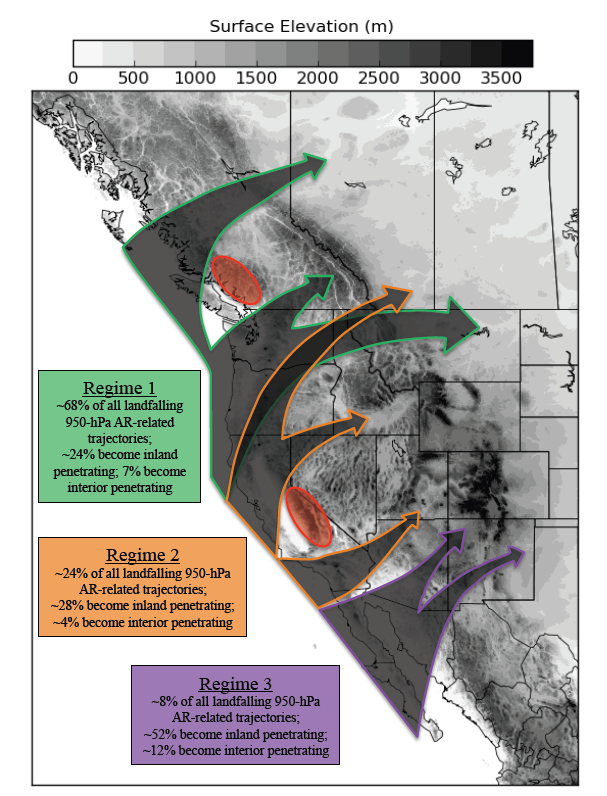CW3E Publication Notice
The Inland Penetration of Atmospheric Rivers over Western North America: A Lagrangian Analysis
June 15, 2015
Jonathan J. Rutz, W. James Steenburgh, and F. Martin Ralph, 2015: The Inland Penetration of Atmospheric Rivers over Western North America: A Lagrangian Analysis. Mon. Wea. Rev., 143, 1924–1944. (Click here for personal-use pdf file of the article)

Schematic from Rutz et al. (2015) showing the primary pathways for the penetration of 950-hPa AR-related trajectories into the interior of western North America. Pathways associated with regimes 1–3 are represented by green, orange, and purple arrows, respectively. Regions associated with frequent AR decay are shaded in red. Topography is shaded in grayscale. Note that while this schematic highlights common regimes and pathways, individual trajectories follow many different paths.
Although atmospheric rivers (ARs) are typically regarded as coastal events, their impacts can be felt further inland as well. Recent work by Rutz et al. (2015) uses a forward trajectory analysis and AR thresholding criteria to examine the inland penetration of ARs over western North America, and identifies geographic corridors where inland-penetrating ARs are most likely. This paper builds on the earlier work led by Jon Rutz (Rutz and Steenburgh 2012 – Atmos. Sci. Lett., and Rutz et al. 2014 – Mon. Wea. Rev.) as part of his PhD dissertation with Jim Steenburgh at Univ. of Utah. Combined with recent results from Alexander et al. (2015, J. Hydrometeor) that used backward trajectories to examine inland penetration of ARs, as well as earlier studies on Arizona AR events (Neiman et al. 2013, Hughes et al. 2014; both in J. Hydrometeor.) and across the west (Ralph et al. 2014; J. Contemporary Water Resources Research and Education), it is now clear that ARs play a critical role in Western U.S. extreme precipitation, even well inland from the coastal areas where they were first studied. These results improve our understanding of water vapor transport and precipitation over the interior western U.S., and hence contribute to ongoing research interests and efforts at CW3E regarding the causes and prediction of extreme weather and water events across the Western U.S.
Abstract
Although atmospheric rivers (ARs) typically weaken following landfall, those that penetrate inland can contribute to heavy precipitation and high-impact weather within the interior of western North America. In this paper, the authors examine the evolution of ARs over western North America using trajectories released at 950 and 700 hPa within cool-season ARs along the Pacific coast. These trajectories are classified as coastal decaying, inland penetrating, or interior penetrating based on whether they remain within an AR upon reaching selected transects over western North America. Interior-penetrating AR trajectories most frequently make landfall along the Oregon coast, but the greatest fraction of landfalling AR trajectories that eventually penetrate into the interior within an AR is found along the Baja Peninsula. In contrast, interior-penetrating AR trajectories rarely traverse the southern “high” Sierra. At landfall, interior-penetrating AR trajectories are associated with a more amplified flow pattern, more southwesterly (vs westerly) flow along the Pacific coast, and larger water vapor transport (qυ). The larger initial qυ of interior-penetrating AR trajectories is due primarily to larger initial water vapor q and wind speed υ for those initiated at 950 and 700 hPa, respectively.
Inland- and interior-penetrating AR trajectories maintain large qυ over the interior partially due to increases in υ that offset decreases in q, particularly in the vicinity of topographical barriers. Therefore, synoptic conditions and trajectory pathways favoring larger initial qυ at the coast, limited water vapor depletion by orographic precipitation, and increases in υ over the interior are keys to differentiating interior-penetrating from coastal-decaying ARs.
